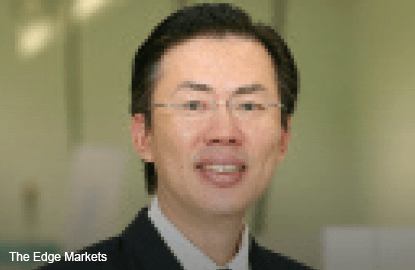
PENANG-based technology company ViTrox Corp Bhd is “cautiously optimistic” about its outlook this year, even as IT research and advisory firm Gartner Inc and global industry association SEMI recently revised downwards their growth forecasts for the semiconductor industry.
“We expect the group’s revenue to remain healthy in financial year ended Dec 31, 2015 (FY2015), but it will be flat or slightly lower compared with FY2014. Hopefully, we can achieve stronger results in the next 12 to 18 months,” ViTrox CEO and president Chu Jenn Weng tells digitaledge Weekly in a recent phone interview.
According to Gartner, the outlook for the main products that drive the semiconductor market, including PCs, smartphones and tablets, has been revised downwards. This, combined with the impact of the strong dollar on demand, prompted it to lower its semiconductor revenue growth forecast for 2015 to 2.2%, from 4%.
Meanwhile, SEMI forecasts the total semiconductor equipment market growing by 7% in 2015 to reach US$40.2 billion, and by a slower 4% in 2016 to US$41.8 billion.
For the first half ended June 30, 2015 (1HFY2015), ViTrox’s net profit declined 20% to RM19 million, from RM24 million a year ago, with revenue dropping 18% to RM72 million from RM88 million.
For its financial year ended Dec 31, 2014 (FY2014, ViTrox (fundamental: 3.0; valuation: 1.5) made a record net profit of RM49 million, on revenue of RM170 million.
It is worth noting that despite strong revenue growth of 60% and profit growth of 100% last year, the company’s long-term target looks a long way off.
To recap, ViTrox had targeted revenue of RM500 million by 2017 or 2018, a workforce of 500, and market capitalisation of RM1 billion, from RM676.9 million currently.
Chu reiterates that ViTrox is maintaining its long-term target of achieving RM900 million in revenue by 2020, and a market cap of as high as RM2 billion, based on a price-earnings ratio of 10 times. At an average profit margin of 25%, the group should generate annual net profit of more than RM200 million by 2020.
“I am very optimistic about the long-term prospects for ViTrox as there will be more devices connected to the internet, coupled with the explosion of big data, whereby more semiconductor chips and automation will be needed around the world. I strongly believe we are moving in the right direction to become a global technology company in the next 10 years,” he says.
ViTrox is the country’s largest solution provider of automated vision inspection systems and equipment. It has three major business segments, namely automated board inspection (ABI), machine vision solution (MVS) and electronics communication system (ECS).
Its products are used in the semiconductor, automotive, telecommunications and electronics packaging industries to detect defects during the manufacturing process.
Chu is the co-founder and single largest shareholder with a 28.2% stake, followed by senior vice-president Steven Siaw Kok Tong and executive director Yeoh Shih Hoong with 20% and 10.7%, respectively.
Going forward, Chu says ViTrox aims to improve its profit margin through effective internal cost control, promoting higher value products, and taking advantage of the appreciation of the US dollar.
ViTrox remains a prime beneficiary of the stronger US dollar as 80% of its sales are denominated in the greenback, compared to only 30% of its raw materials.
In an Aug 10 report, Maybank Investment Bank Bhd analyst Ivan Yap says a sensitivity analysis suggests that every 1% change in forex will impact ViTrox’s bottom line by 2%.
In another note on Aug 24, he says despite a weaker-than-expected outlook in 2015, he remains positive on ViTrox’s longer-term earnings growth prospects.
“Lower unit sales were bolstered by higher average selling prices as we assume 3.85 per dollar average from 3.60 per dollar previously,” he says.
Yap maintains a “buy” on the stock, with a slightly lower target price of RM3.65, transalating into an upside potential of 28.98% at its closing price of RM2.83 last Friday.
Chu says the forex gain is a bonus for ViTrox, but is only a temporary advantage because it has no control over currency trends.
“We would rather pay more attention to expanding our product range and customer base to mitigate the market volatility,” he says.
ViTrox will continue to strengthen its presence in China, America, Europe, India and Southeast Asia through its internal sales force and sales channel partners, he adds.
ViTrox’ share price has retraced 25.7% in the last four months from its all-time high of RM3.81 on April 21.
The counter is currently trading at a historical price-earnings ratio (PER) of 13.8 times. At its peak, the stock’s PER was as high as 18.1 times.
“To me, the current share price of ViTrox is very attractive. Our shares have been undervalued” says Chu, pointing out that the stock is trading at a lower PER against its peers.
Globetronics Technology Bhd (fundamental: 3; valuation: 1.70), Unisem (M) Bhd (fundamental: 1.80; valuation: 1.2) and Inari Amertron Bhd (fundamental: 3.00; valuation: 1.50), have comparatively higher historical PERs of 25.6 times, 19.1 times and 15.4 times, respectively.
Malaysian Pacific Industries Bhd (fundamental: 2.10; valuation: 2), which has seen its share price gain 48% year to date, has the lowest PER of 12.3 times.
Chu says the market conditions may change but the group’s direction remains firm. “If you had invested in ViTrox five years ago, you would have seen our share price grow more than five times from below 50 sen to RM3.”

This article first appeared in digitaledge Weekly, on September 7 - 13, 2015.